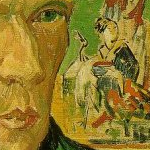 It wasn't as if I'd never heard of the man . . .
It wasn't as if I'd never heard of the man . . .
As difficult as it is for some people to believe, I conceived of, researched, and began writing my Van Gogh novel Yellow before I knew of Irving Stone's earlier Van Gogh novel Lust for Life. Sure, I knew Stone's name. I'd heard of The Agony and The Ecstasy, his fictional take on Michelangelo, if only because of the celebrated 1965 film starring Charlton Heston, a staple of local "4:00 Movie" programs during the pre-cable 70s of my childhood. But I think it was my wife who casually asked one day, "You do know he wrote a novel about Van Gogh too, don't you?" Uhh . . . Truly, my blood ran a little cold. But with some quick internet leg work I found the dates on Lust for Life the novel (1934) and the movie (1956). I breathed a little easier. After all, the book was published more than seventy years in the past. Should a book from that long ago permanently mark as "Off Limits" a famous man's life? It's one thing if the book was 10 or 20 years old, but 70? If anything, I figured it was time for an updated examination of the painter. Isn't that what writers and scholars are supposed to do? After all, in my research for the novel it became clear that the number of Van Gogh biographies ran into the dozens. Dozens of biographies, but only one novel allowed? Surely not. And, besides, how many other people--and here I mean readers, not just the public in general--were probably as ignorant of Stone's book as I was?
So I happily solidered on, spending years drafting, revising, editing, and shaping Yellow. The result is an admittedly long novel--though I cut out a great deal--but long for a good reason: I'm showing Van Gogh over virtually his whole life span, from his childhood in rural Brabant to his release from St. Paul's mental hospital in Saint-Remy, France, three months before he died. I realized, of course, that some agents and editors might balk at a novel close to 800 pages long. What I didn't expect, but what I've heard recently, is concern over the legacy of Stone. Lust for Life, I hear from some quarters, is simply too embedded in our culture--it's still in print and still selling well--squeezing out the possibility that any other novel can try to tell the story of Vincent's whole life. If one writes about Van Gogh these days, it must be from a drastically restricted vantage point. It's disheartening to hear such opinions, not only because it means the speaker won't be representing my novel, but also because I suspect the speaker is misguided. After all, another way to think about the same set of facts is this: The continued success of Lust for Life, more than seventy years after its first publication, shows just how deeply ingrained is western society's fascination with Van Gogh, how we revel in his many evident quirks and gape awestruck at his determination, how we see him as the truest archetype for the iconoclastic, starving artist--a "real" artist if you will. And how willing we are to lay down money for him. If we're that interested in Van Gogh, doesn't this suggest other Van Gogh books could succeed as well as Lust for Life? Or simply succeed? After all, our media--books, television, movies--is, if anything, famous for its willingness to recycle ideas and characters. How many Da Vinci Code knockoffs appeared in the wake of Dan Brown's book?How many new vampire series have appeared in the last five years? Yet there's only room for one Van Gogh novel?
Ironically, Yellow isn't a knockoff of anything. I still haven't read Stone's book, though I'm certainly more aware of it these days. While I was writing, I avoided it on purpose. I had a pretty clear idea of what I wanted to achieve in Yellow, and I didn't want to feel like I had to pull back or change course because of something Stone did; whether that meant trying to avoid being like Stone or trying to actually mimic something about Lust for Life that I admired. I wanted and needed to stay true to my own vision of Van Gogh and of my novel. That seemed easiest to do without Irving Stone's 70+ year old Van Gogh vision running through my head. And it seemed the only way to make a Van Gogh biographical that could stand on its own and draw new generations of readers. Even now, as I'm more or less done with the book, I still don't seek out Lust for Life. In part it's lethargy, in part it's because I have so much else, for a variety of reasons, that I simply have to read. But of course, having not read Lust for Life, I am arguably not the best person to say whether Yellow charts new territory or not. So what do you all think? Does it sound like I have case, or does it seem true to you that Lust for Life has permanently coopted Vincent Van Gogh from fiction?
I began this project after being so purely blown away by the Van Gogh paintings I saw in Amsterdam's Van Gogh Museum. My feelings were so stirred they simply demanded a fictional response. I didn't know what else to do with them. I simply couldn't turn this subject down. I still believe I made the right decision in pursuing it. But Irving Stone is trying his best to shake that belief.









 0
0



